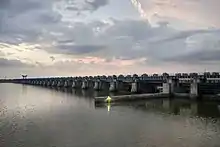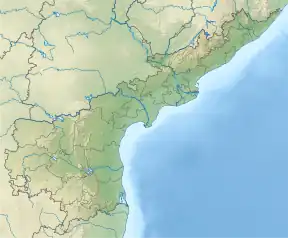| Sunkesula Barrage | |
|---|---|
 | |
 Location of Sunkesula Barrage in Andhra Pradesh | |
| Official name | Tungabhadra Barrage |
| Country | India |
| Location | Kurnool, Kurnool District , Andhra Pradesh && Rajoli, Jogulamba Gadwal district, Telangana |
| Coordinates | 15°52′57″N 77°49′38″E / 15.88250°N 77.82722°E |
| Purpose | Irrigation & Water supply |
| Construction began | 1858 |
| Opening date | 1861 |
| Owner(s) | Government of Andhra Pradesh |
| Dam and spillways | |
| Type of dam | Barrage |
| Impounds | Tungabhadra River |
| Height | 163 m (535 ft) |
| Length | 1,300 m (4,265 ft) |
| Spillways | 30 |
| Spillway type | Controlled |
| Spillway capacity | 2,08,363 cumecs |
| Reservoir | |
| Creates | Sunkesula Reservoir |
| Total capacity | 1.25 Tmcft |
| Catchment area | 172 km2 (66 sq mi) |
| Surface area | 60.32 km2 (23.29 sq mi) |
| Website irrigationap | |
Sunkesula is one of the largest barrages across the Tungabhadra River in Kurnool district,[1][2] Andhra Pradesh, India.[3][4] It was built in 1861, during the British raj, for transporting goods on the K. C. Canal.
References
- ↑ "Sunkesula_Barrage_B01016". Retrieved 23 December 2015.
- ↑ "CII to adopt Sunkesula village". The Hindu. 31 October 2009. Archived from the original on 31 December 2009.
- ↑ "Sunkesula barrage suffers extensive damage". The Hindu. 7 October 2009. Archived from the original on 10 October 2009.
- ↑ "Sunkesula in peril". The Hindu. 2 October 2009. Archived from the original on 18 September 2011.
This article is issued from Wikipedia. The text is licensed under Creative Commons - Attribution - Sharealike. Additional terms may apply for the media files.